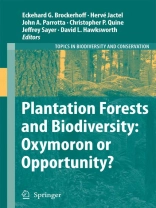1 Plantation forests and biodiversity: Oxymoron or opportunity? Forests form the natural vegetation over much of the Earth’s land, and they are critical for the survival of innumerable organisms. The ongoing loss of natural forests, which in some regions may have taken many millennia to develop, is one of the main reasons for the decline of biodiversity. Preventing the further destruction of forests and protecting species and ecosystems within forests have become central issues for environmental agencies, forest managers, and gove- ments. In this di?cult task science has an important role in informing policy and management as to how to go about this. So how do industrial and other pl- tation forests ?t into this? Plantation forests, comprised of rows of planted trees that may be destined for pulp or sawmills after only a few years of growth, appear to have little to c- tribute to the conservation of biodiversity. Yet there is more to this than meets the eye (of the casual observer), and there are indeed numerous opportunities, and often untapped potential, for biodiversity conservation in plantation forestry. With plantation forests expanding at a rate of approximately three million hectares per year, it is crucial to understand how plantations can make a positive contribution to biodiversity conservation and how the potentially negative impacts of this land use can be minimised. That is the topic of this book.
Inhoudsopgave
Plantation forests and biodiversity: oxymoron or opportunity?.- Epiphytes of Sitka spruce (Picea sitchensis) plantations in Ireland and the effects of open spaces.- Bird assemblages in pine plantations replacing native ecosystems in NW Patagonia.- Identifying practical indicators of biodiversity for stand-level management of plantation forests.- Options for biodiversity conservation in managed forest landscapes of multiple ownerships in Oregon and Washington, USA.- Impact of four silvicultural systems on birds in the Belgian Ardenne: implications for biodiversity in plantation forests.- The early effects of afforestation on biodiversity of grasslands in Ireland.- Multi-scale habitat selection and foraging ecology of the eurasian hoopoe (Upupa epops) in pine plantations.- Diversity and composition of fruit-feeding butterflies in tropical Eucalyptus plantations.- Impact of landscape and corridor design on primates in a large-scale industrial tropical plantation landscape.- Non-native plantation forests as alternative habitat for native forest beetles in a heavily modified landscape.- Importance of semi-natural habitats for the conservation of butterfly communities in landscapes dominated by pine plantations.- Relevance of exotic pine plantations as a surrogate habitat for ground beetles (Carabidae) where native forest is rare.- Stand-level management of plantations to improve biodiversity values.












